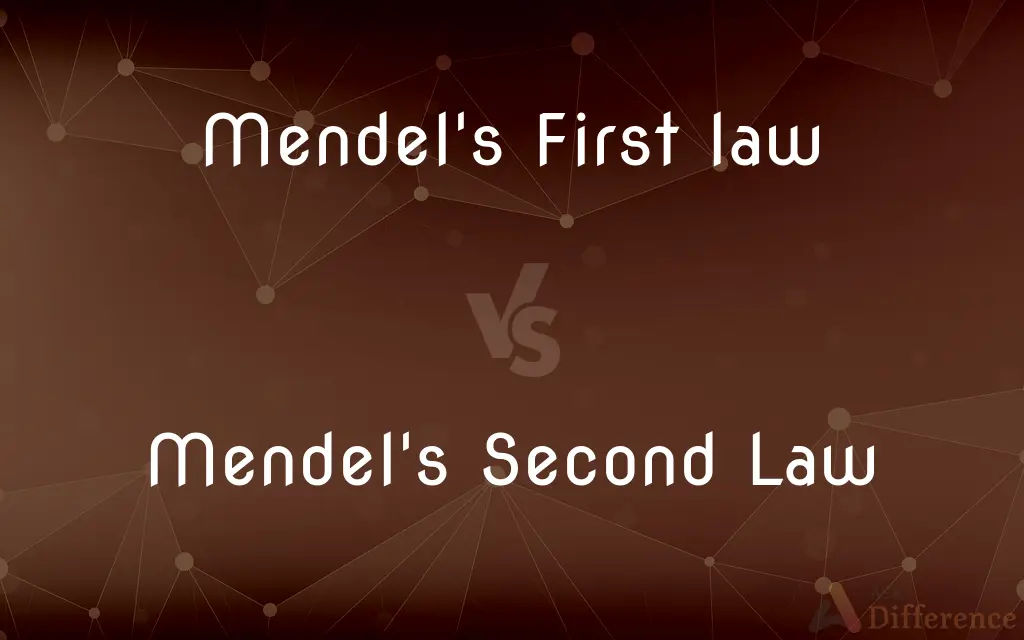Mendel's First law vs. Mendel's Second Law — What's the Difference?
By Tayyaba Rehman — Published on January 12, 2024
Mendel's First Law (Law of Segregation) states that allele pairs separate during gamete formation, while his Second Law (Law of Independent Assortment) states that genes for different traits assort independently.

Difference Between Mendel's First law and Mendel's Second Law
Table of Contents
ADVERTISEMENT
Key Differences
Mendel's First Law, also known as the Law of Segregation, posits that during gamete formation, alleles for each gene separate so each gamete carries only one allele for each gene. In contrast, Mendel's Second Law, the Law of Independent Assortment, suggests that genes for different traits can segregate independently during the formation of gametes.
According to Mendel's First Law, an organism with two alleles for a trait will separate these alleles during reproduction, ensuring offspring receive one allele from each parent. Meanwhile, Mendel's Second Law implies that the inheritance of one trait is independent of the inheritance of another trait.
Mendel's First Law is evident in simple Mendelian inheritance where traits are determined by a single gene. On the other hand, Mendel's Second Law becomes significant in dihybrid or polygenic inheritance, where multiple genes influence traits.
The Law of Segregation (Mendel's First Law) explains why dominant and recessive traits appear in specific ratios. In contrast, the Law of Independent Assortment (Mendel's Second Law) accounts for the genetic variation observed when examining two or more traits simultaneously.
While Mendel's First Law focuses on how alleles for a single gene are transmitted, his Second Law deals with the transmission of alleles for two or more genes and their independent assortment during gamete formation.
ADVERTISEMENT
Comparison Chart
Also Known As
Law of Segregation
Law of Independent Assortment
Focus on Genes
Single gene
Multiple genes
Genetic Transmission
Alleles separate during gamete formation
Genes for different traits assort independently
Impact on Traits
Explains dominant/recessive patterns
Accounts for genetic variation in multiple traits
Application in Inheritance
Simple Mendelian traits
Dihybrid or polygenic traits
Compare with Definitions
Mendel's First law
Each gamete carries only one allele for each gene.
Mendel's First Law explains why a child inherits only one eye color allele from each parent.
Mendel's Second Law
Genes for different traits assort independently.
Mendel's Second Law demonstrated that pea color and pea shape traits were inherited independently.
Mendel's First law
Fundamental principle of genetic segregation.
Mendel's First Law was exemplified when the offspring inherited either a wrinkled or smooth pea trait, but not both.
Mendel's Second Law
Fundamental principle for predicting outcomes of crosses involving multiple genes.
Mendel's Second Law helped in predicting the possible combinations of traits in offspring with two varying traits.
Mendel's First law
Basis for dominant and recessive trait inheritance.
According to Mendel's First Law, the dominant allele for brown eyes overshadowed the recessive allele for blue eyes.
Mendel's Second Law
Basis for dihybrid and polygenic trait inheritance.
In dihybrid crosses, Mendel's Second Law predicted the 9:3:3:1 phenotypic ratio.
Mendel's First law
Alleles for a gene separate during gamete formation.
In pea plants, the allele for tall stems separated from the allele for short stems according to Mendel's First Law.
Mendel's Second Law
Explains genetic variation with multiple traits.
According to Mendel's Second Law, a plant could inherit the trait for yellow peas independently from the trait for tall stems.
Mendel's First law
Explains inheritance of single-gene traits.
Mendel's First Law clarified why certain diseases caused by a single gene followed predictable patterns.
Mendel's Second Law
Alleles of different genes segregate independently during gamete formation.
Mendel's Second Law explains the variety in eye color and hair color inheritance in humans.
Common Curiosities
How does Mendel's First Law affect inheritance?
It explains dominant and recessive patterns and single-gene trait inheritance.
What is Mendel's First Law?
It's the Law of Segregation, stating alleles for a gene separate during gamete formation.
What does Mendel's Second Law state?
Known as the Law of Independent Assortment, it states genes for different traits assort independently.
What is the significance of Mendel's Second Law?
It accounts for genetic variation and inheritance of multiple traits.
Does Mendel's First Law apply to multiple genes?
No, it mainly applies to single-gene traits.
What experiments led to Mendel's Second Law?
Dihybrid crosses involving two traits, like pea color and pea shape.
Did Mendel's Laws apply to humans?
Yes, they form the basis for understanding human genetic inheritance.
Can Mendel's Second Law predict single trait inheritance?
It's more relevant for dihybrid or polygenic traits.
How did Mendel discover his First Law?
Through breeding experiments with pea plants, observing single-trait inheritance.
Can Mendel's First Law predict trait combinations?
Not combinations, but it predicts patterns for single traits.
Are there exceptions to Mendel's Second Law?
Yes, in cases of linked genes or chromosomal abnormalities.
Is Mendel's First Law always accurate?
Generally, yes, but there are exceptions like linked genes.
How does Mendel's Second Law help in breeding?
It aids in predicting outcomes when breeding for multiple traits.
How does Mendel's Second Law contribute to genetic diversity?
By allowing different traits to be inherited independently, it increases variation.
Why is Mendel's First Law important in genetics?
It's foundational for understanding basic genetic inheritance.
Share Your Discovery

Previous Comparison
Delegates in C# vs. Events in C#
Next Comparison
Ganon vs. GanondorfAuthor Spotlight
Written by
Tayyaba RehmanTayyaba Rehman is a distinguished writer, currently serving as a primary contributor to askdifference.com. As a researcher in semantics and etymology, Tayyaba's passion for the complexity of languages and their distinctions has found a perfect home on the platform. Tayyaba delves into the intricacies of language, distinguishing between commonly confused words and phrases, thereby providing clarity for readers worldwide.
















































